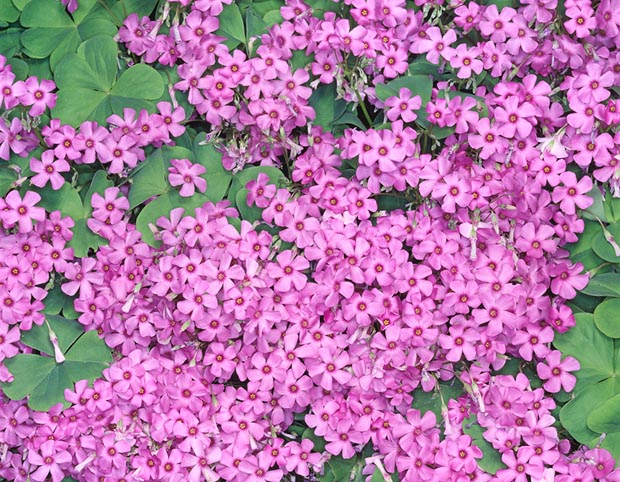Family : Oxalidaceae

Text © Pietro Puccio

English translation by Mario Beltramini

Easy to cultivate, Oxalis floribunda bears the cold but loves the sun © Giuseppe Mazza
The name of the genus is the combination of the Greek terms “oxys” = acid and “hals, halós” = salt with reference to the acidulous and salted taste of the plant; the name of the species is the neo-Latin term “floribunda” = which produces many flowers, floriferous.
Common names: bent wood-sorrel, bent woodsorrel, jointed woodsorrel, oxalis, pink oxalis, pink sorrel, pink wood sorrel, pink-sorrel, shamrock, shamrock oxalis, sorrel, sourgrass, wood sorrel (English); oxalis rose (French); acetosella floribunda, trifoglio fiorifero (Italian); vinagrillo, vinagrillo morado (Spanish); Wald-Sauerklee (German).
The Oxalis floribunda Lehm. (1826) is a perennial herbaceous plant, 10-40 cm tall with rhizomatous roots and short herbaceous stem, erect, rather fleshy, much ramified, and persistent leaves formed by three obcordate small leaves, slightly tomentose, about 1,5 cm long and broad, on a 5-15 cm long peduncle. The numerous axillar inflorescences, on a 10-18 cm long scape, filiform, enlarged at the base, are umbelliform cymes carrying a variable number of flowers on about 3,5 cm long pedicels, initially hanging, then erect by the opening of the flower, with green oblong sepals with two red lines at the apex, funnel-shaped corolla with five obcordate-cuneate petals, with crenate apex, 1-1,5 cm long, finely pubescent below, of pink colour with darker venations; a white-flower variety does exist. The fruits are pointed capsules, 1-2 cm long.
It reproduces by seed and, very easily, by division. It is a species having the phenomenon of the heterostyly, with at least two types of flowers, some with short styles which do not exceed the length of the anthers, other with longer styles; this hinders the self-fecundation and renders necessary the crossed-fertilization, therefore, if there is present only one type there will not be production of seeds and the diffusion will take place through the rhizomatous roots. Much appreciated species due to its long flowering, which continues from spring to autumn, the facility of cultivation and the rusticity, as it can bear temperatures down to -15 °C at level of the rhizomatous roots.
For the best flowering, it requires full sun or, at most, a slight shade; it is not particular for what the soils are concerned even if it prefers the light ones, rich of organic substance and sandy. Particularly suitable for borders, rocky gardens and as ground cover; we have to keep in mind that it is potentially a pest, as it quickly expands with its rhizomatous roots. It is suitable also for the cultivation in pot utilizing a well draining mould with the above cited characteristics.
Synonyms: Oxalis martii Lodd. (1829); Oxalis sericea (Progel) Arechav. (1900); Oxalis glandulosa Larrañaga (1923); Oxalis arechavaletae Herter (1943).
